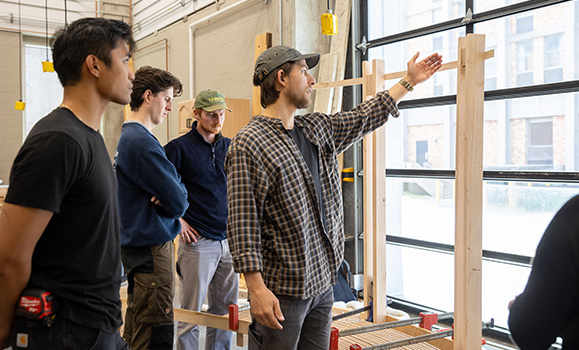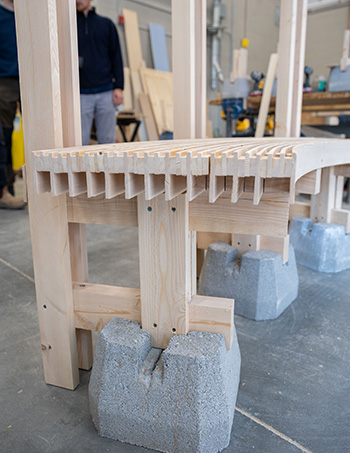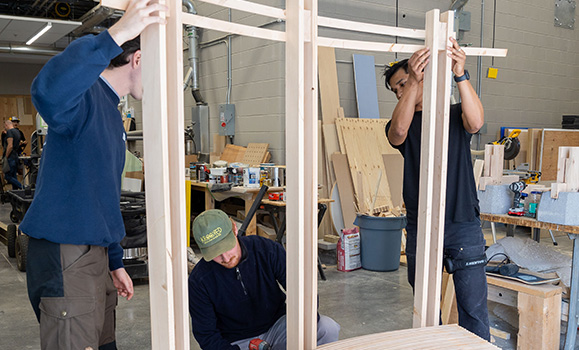When biology student Emily McLean (pictured below) applied for funding to create pollinator walls on campus, she had no idea it was the start of an incredible collaboration.
 “I sent in the application and then things began progressing. The idea fell into the hands of the School of Architecture, where it developed into this amazing project. It’s more than I could have ever envisioned,” says McLean. “It’s so much better thanks to everyone here who has volunteered their time to make this happen.”
“I sent in the application and then things began progressing. The idea fell into the hands of the School of Architecture, where it developed into this amazing project. It’s more than I could have ever envisioned,” says McLean. “It’s so much better thanks to everyone here who has volunteered their time to make this happen.”
With support from the Office of Sustainability, and the , McLean has been coordinating and working with various groups on campus. Students at the School of Architecture have taken responsibility for the design, build, and installation of the wall. And students from Civil Engineering and Environmental Engineering were part of early development.
Sit and observe
Fully funded by the World Wildlife Foundation, the project is designed to both create a space for pollinators and invite people to observe and enjoy nature.
“Emily’s fascination with observing bees has now been translated through this project in a public way,” says Master of Architecture student Nick Stefanakis. “So now we are creating this piece where other people can enjoy observing bees and it will fight the stigma and fear and make it okay to celebrate observing bees and other insects.”
The project includes two pollinator walls and a standalone planter that will be installed in the naturalized area between Sheriff Hall and the Steele Ocean Sciences building. All walls will have a bench and a planter filled with native, flowering perennials. The standalone planter will provide a viewing point for people sitting on either of the benches.

Nick Stefanakis and contributing Master of Architecture students discuss the project.
The Urban Garden Society and the Dalhousie Beekeeping Society are helping with planting and maintenance of the area. Volunteers are welcome to as part of Dalhousie Biodiversity Week.
 By design
By design
“It took lots of experimentation on the architectural side because we designed it to have curves,” explains Stefanakis. “We started the process of steam bending but the hemlock from the mill had enough moisture in it and so through a series of prototypes we figured out the ideal thickness of the material to take the curve without going through the steam bending process. For us in the shop, that was a really cool experience.“
The design features one side of the wall for pollinators and one side for people — in the middle there’s observation. The walls are dimensioned to work between pairs of trees and won’t disturb the current environment. The choice of hemlock, which has a natural defense against pests, means the wood doesn’t have to be treated chemically.
 In print
In print
“Projects like these are great because we can integrate some of our research work into built work,” says Brian Lilley, associate professor in the School of Architecture.
Ceramic bricks have been printed on campus with a gentle curve that will form a snug wall along the back of the wooden structure. As the process is intensive, students weren’t able to print the entire perimeter, so standard bricks from Shaw will fill out the rest of the planter. The clay bricks were printed with a mixture developed by NSCAD. They have been carefully designed to catch moisture and feed it into the soil.
“The idea with the loops in the bricks is something we’ve been doing on a small scale for a couple months.,” says Jack Kinnie, Master of Architecture student (pictured here to the left of fellow student Jam Basilio). “This is our first application of a large-scale project that will actually be in use. It’s been a lot of work and I'm glad to see it come together.”
Flora and fauna
The vine on the wall will be lonicera sempervirens, which is red so it will attract different pollinators but many of the native perennials in the planters will have colours to attract bees.
“Bees have a favourite colour,” McLean explains. "They love blue, violet, and purple because they are attracted to shorter wavelengths.”

Students begin building the lattice for the pollinator wall.
Fifteen of Canada’s wild bee species are listed as threatened. Habitat loss is mainly the result of intensified agriculture and urban development, leading to the loss of foraging and nesting habitat.
“I think to incorporate people peacefully into nature is great and it allows people to learn more and maybe reduce those fears that people have,” says McLean. “Only female bees have stingers, and they only sting when threatened. When they’re out foraging, they don’t want to attack us, they just want to bee.”
Learn more:

